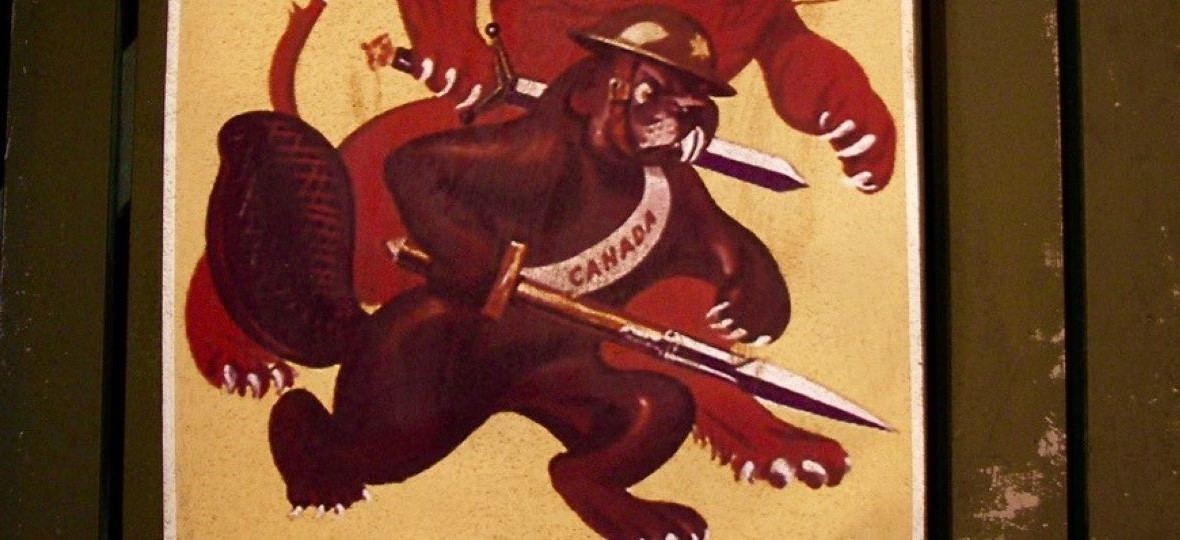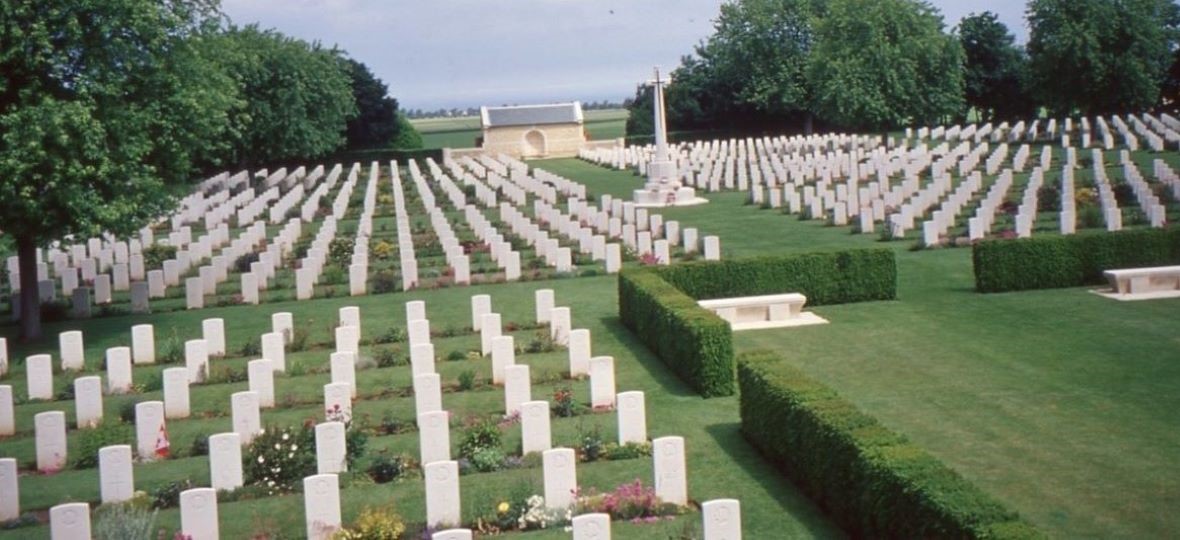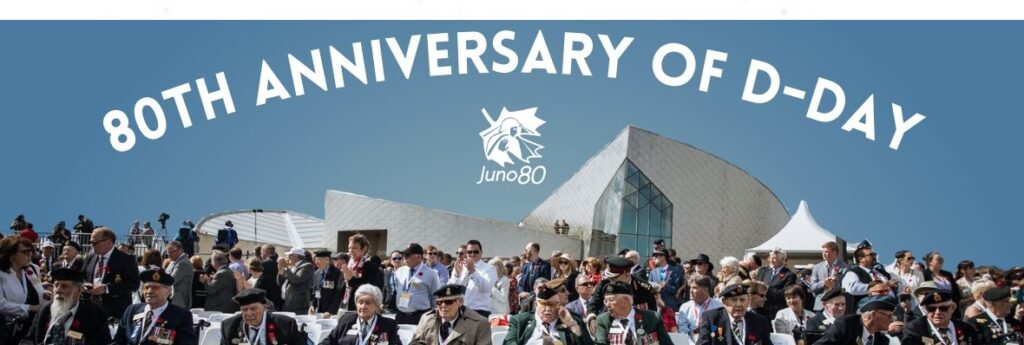For a few moments the sky over Normandy, France, seemed to bleed. A helicopter, camouflaged to match the blue horizon, hovered over the beach at Courseulles-sur-Mer, dropping poppies. First in bursts of red clouds, then spread out on the breeze, like blood droplets dispersed in water. Each blood-red flower represented a Canadian killed in World War II. In all, 48,000 poppies fluttered onto the beach, building and crowd below.
The crowd below included 1,300 Canadian D-Day veterans, 3,000 of their family members as well as Prime Minister Jean Chretien, French Prime Minister Jean-Pierre Raffarin, attending the opening of the Juno Beach Centre on June 6, 2003. The objective was to finally have something ready for the 60th anniversary of the invasion.
Tomorrow (Thursday), the King, Queen, Prince of Wales, President Biden, Prime Minister Trudeau, and the heads of state for 26 countries will join French President Macron on the invasion beaches to commemorate the 80th anniversary of the world’s greatest military campaign Operation Overlord, aka D-Day, and liberation of Europe. This launches ‘Rendezvous with the World,’ which is 11 months of commemorations leading to the 80th anniversary of the end of World War Two.
Juno Beach is where Canadians landed on D-Day. The Juno Beach Centre is a memorial to World War Two created by D-Day veterans. The late Garth Webb, a retired real estate appraiser from Etobicoke and one of 14,000 Canadians who landed here on June 6, 1944, said the Juno Centre was built by Canadian veterans “to tell the story of Canada in WWII. WWI is told at Vimy Ridge, but there was no place that told the WWII story in Europe. We got the idea when we were over on the 50th anniversary of D-Day” and saw how Canada’s role in the invasion and World War II was being forgotten.
While regrettable, it was understandable because those Canadians fortunate enough to return home from both world wars never spoke of their experiences. My father was part of the lesser-known Italian Campaign. He fought his way up the boot of Italy, across France and Belgium, participated in the liberation of The Netherlands and went into Germany. Like his comrades my father’s war was a past he didn’t care to relive. While Canadians were silent, other Allies weren’t and their memories provided the material for books and films that focused on American and British roles in the invasion and war.
What many Canadians don’t know is that the invasion of Europe was conceived at a 1941 meeting of British Prime Minister Winston Churchill and US President Franklin Roosevelt in Placentia Bay, Nfld. As a result, 700 generals, admirals, air- and field-marshals and their staff met at the Chateau Frontenac and Quebec Citadel to plan the invasion. The original battleplan with the James Bond-sounding codename, Skyscraper, was written by a Canadian. In 1943 Churchill, Roosevelt and Canadian Prime Minister Mackenzie King met in Quebec City to approve plans for Operation Overlord.
These were probably the most consequential meetings of the 20th century because the public had no idea how dire the situation was. My first publisher, George Baker from Kentville, NS, a Major in the Royal Canadian Signal Corps, wrote in a privately published memoir of going into the War Room at Army Headquarters in London in 1942 “… At the time, the map in the War Room showed 53 German divisions on the channel coast and only ten to fifteen Allied divisions available for an assault.”
To counter these overwhelming odds Baker’s role was to oversee the transmission of coded wireless messages in a volume to imitate “an imaginary American armoured corps, ready to take part in an assault across the Channel at its narrowest point.” This diverted German resources away from Normandy and made them hesitant to invade Britain believing there was great Allied force ready to decimate an invasion force.

Baker landed in France on June 10 and from then until the end of the war personally oversaw the communications for five Canadian divisions. He received the MBE (Most Excellent Order of the British Empire) for his role in the invasion.
Baker also wrote of a group of Canadians who “solved the German tactical code every day by 11 o’clock in the morning. The section was able to do this because of German fondness for routine. Every morning a German aircraft went to the same designated spots in the English Channel, made the same weather observations and reported in the same form. The cryptographers knew from our own radar and weather data what the messages contained and that made it a routine matter to break the code.”
Another significant contribution came from Imperial Oil’s asphalt expert, Charles Baskin, who developed a prefabricated airstrip, which enabled military engineers to roll out, like a sheet of wrapping paper, a full, working runway in 24 hours versus several weeks using traditional construction methods.
Beyond the planning, Canadians were also on the front lines. The late Mark Lockyer from Whitby, Ont., was with the First Canadian Parachute Battalion’s 6th Airborne Division. At 12:45 am June 6, Lockyer landed in a glider 10 km. behind enemy lines. “It was our job to blow three bridges on the River Dives and then make certain that they were not rebuilt or refurbished.” This kept the German 15th Army from advancing on the invasion beaches. He was 18 years old.
Lockyer recalled that, when he was in the glider on his way to France, a break in the clouds allowed him to see the invasion fleet below. “The English Channel, from about halfway out back to the English coast, was boats, upon boats, upon boats. It looked like you could almost jump from ship-to-ship to get back to England.”
Russel Hubley, a 20-year-old mid-upper gunner with RCAF 431 Squadron from Halifax, was part of the crew which dropped the first bombs in the invasion. “We thought we were going on a regular raid to bomb a heavy gun emplacement inside France. When we got back, we went to the briefing, they just said, ‘You have just opened the invasion.’ That’s when we found out. We were surprised. They were pretty secretive.” Hubley received the Distinguished Flying Cross.
The only force to meet its D-Day invasion targets were The Queen’s Own Rifles from Canada.
One member of the Queen’s Own was 19-year-old Bill Ross from Montreal. His day began dashing across the wide sandy stretch of beach at Bernieres-sur-Mer, where he says, “We were just faced with snipers and minefields.” While a comrade stopped him from stepping on a land mine, he was wounded later in the campaign. Of the eight men who joined the regiment with Ross, five were wounded, one was killed, one taken prisoner and one suffered shellshock.
Historian Terry Copp says the story of Juno Beach is one of “extraordinary achievement. We were a nation of 11 million people, emerging from severe depression, that put slightly over one million men and women in uniform and contributed significantly to all of the major Allied operations in the European war. One quarter of all the air crews in Bomber Command were Canadian. In the tactical airforces that flew over Normandy in the early part of the Normandy Campaign, half the squadrons were Canadian. Royal Canadian Navy flotillas helped to bring troops to the Normandy beaches, and Canadian frigates and Corvettes protected the armada. The Canadian 31st Minesweeping Flotilla brought the American troops into Omaha Beach. Canada has a story worth telling.”
Canada’s wartime generations left a large legacy which should be better known.
Of interest to Canadian travellers

Normandy has a myriad of museums dedicated to the invasion. The Juno Beach Centre is solely dedicated to the Canadian story. The Caen Memorial, while sounding like a statue, is a large war museum with significant Canadian content and a Canadian Garden. The Ardenne Abbey also has a Canada Garden commemorating the murder of 20 Canadians by the Nazi SS.
Near the Juno Beach Centre is the Canadian War Cemetery at Beny-sur-Mer (photo above). It contains the remains of 2.043 Canadians who died in the invasion. The Commonwealth War Graves Commission maintains on-line information about the location of fallen Allied soldiers. In addition to on-line resources, the entrance of each Commonwealth war cemetery contains a logbook detailing the location of individuals on-site.
In preparation for Rendezvous with the World, the Juno Beach Centre and Atout France have developed a route across Northern France – from Normandy to Dieppe, Vimy and French Flanders – focused on locations and places where Canadians fought in both world wars.
It is possible to easily build an individual itinerary or book a package tour that includes a Canadian focus.

